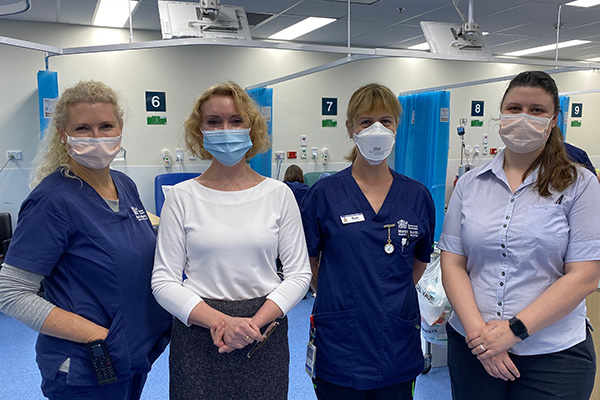Practice change gives patients more control over treatment
A change in blood management therapeutic practice at The Prince Charles Hospital (TPCH) is allowing patients with immune deficiency to actively manage their health more effectively from home.
Subcutaneous immunoglobulin (SCIg) is a form of immunoglobulin replacement therapy (IRT) used to treat patients with antibody deficiency as a result of an immune system weakness.
Blood Management Clinical Nurse Consultant, Dr Bronwyn Pearse said that IRT replaces essential immunoglobulins (commonly known as antibodies) for those patients who are unable to make enough of their own antibodies, or who have antibodies that don’t work properly.
“Replacing a mixture of antibodies with this therapy helps to protect against infection and can prevent long term damage from ongoing infections,” Bronwyn said.
“IRT is generally a lifelong therapy, traditionally administered as an IV infusion in a hospital-based setting on a fortnightly or monthly basis depending on a patient’s clinical condition.”

Some members of the Subcutaneous immunoglobulin therapy project team
With IV infusion, patients receive the immunoglobulin therapy via a cannular inserted into an arm vein or a portacath, over a 4 to 6 hour period during each visit to TPCH’s Day Unit for Investigation and Therapy.
Over time, the constant cannular insertion into the arm veins can result in some trauma to the arm veins, resulting in patients being no longer able to receive this method of infusion and requiring a portacath.
Portacaths are an implanted venous access device placed under the skin on the chest and provide permanent access for patients who require long-term administration of intravenous infusions.
“IV fusion also involves a significant time commitment for patients who often have to take regular time off work to receive treatment in the hospital,” Bronwyn said.
Unlike IV infusion, SCIg is administered under the skin via tiny needles into the stomach which release the mixture of antibodies into the body. This therapy can be administered at home by the patient or their carer, at a time that is convenient to the patient in between other commitments.
“While this type of therapy is required more frequently at weekly intervals, it gives patients greater flexibility and an active role in managing their treatment at home,” Bronwyn said.
Research also indicates that subcutaneous immunoglobulin therapy is more effective in maintaining a steady state of immunoglobulin levels, thereby reducing clinical symptoms associated with peaks and troughs as seen in IV infusion administration.
Patient Sharon Stower has benefitted from the change in practice, having recently transitioned to subcutaneous immunoglobulin therapy after more than a decade of receiving IV infusion through a portacath at TPCH.
With the assistance of her husband, Sharon now spends about two and half hours each week administering her treatment from the comfort of her home and she no longer requires the portacath.
“Having my treatment from home is so much quicker and easier, and I can give it at a time that suits me,” Sharon said.
“Because I have my therapy weekly, it means I have more energy and generally feel better overall.”
